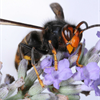05 July 2017

Island residents are asked to look out for nests of a new hornet to the Island.
The Asian hornet (Vespa velutina) is spreading across France, and was first found in Jersey last year. This year two nests have been found in Jersey; one in St Martin, and another in St John.
The nest found recently in an outhouse, near Fliquet, St Martin, was destroyed and removed by Department of the Environment scientists, working with members of the Jersey Bee Keepers Association.
Hornets play a crucial role in the ecosystem in controlling other insects and pollinating fruit and flowers, but the Asian hornet is a predator of native insects and is a threat to honey bees and other pollinators.
What to do if you suspect an Asian hornet
It is no more of a threat to humans than native wasps and hornets but people should take care if they suspect Asian hornets in the area. The main advice is:
- check the Asian hornet ID sheet which outlines the main differences between the native European hornet and the Asian hornet
- don’t disturb an active nest – these are usually high in trees and man-made structures but sometimes closer to the ground in outbuildings or sheds
- report your sighting. If you suspect you have found Asian hornets or a nest, read the Asian hornet ID sheet (also available at Howard Davis Farm reception) which outlines the main differences between the native European hornet and the Asian hornet, and then send a photograph and location information to the Department of the Environment (contact details below)
Monitoring
The Department of Environment, working with Jersey beekeepers, has been monitoring for the Asian hornet for more than five years. Earlier this year it placed traps at 30 sites around the Island.
The Department’s entomologist (insect expert) and Head of Plant Health, Scott Meadows say they hope to trap several hornets and follow them to find out where the nests are.
All the Channel Islands are working together and last year stepped up monitoring and trapping programmes.
The Asian hornet is slightly smaller than the native European hornet (Vespa crabro). It is not easily confused with any other species, it is the only hornet or wasp with an entirely dark brown or black velvety body, bordered with a fine yellow band, and yellow legs.
Email the Department of the Environment
Phone the Department of the Environment on +44 1534 441600.
Further information
States of Jersey gov.je http://www.gov.je/Environment/LandMarineWildlife/Insects/Pages/index.aspx
Department for Environment, Food & Rural Affairs https://secure.fera.defra.gov.uk/beebase/index.cfm?pageid=208
Hymettus http://hymettus.org.uk/downloads/Info_sheets_2010/12_Vespa_velutina_1col_infosheet.pdf